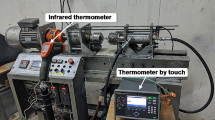Abstract
AA1100 aluminum alloy has gathered wide acceptance in the fabrication of light weight structures. Friction stir welding process (FSW) is an emerging solid state joining process in which the material that is being welded does not melt and recast. The process and tool parameters of FSW play a major role in deciding the joint characteristics. In this research, the relationships between the FSW parameters (rotational speed, welding speed, axial force, shoulder diameter, pin diameter, and tool hardness) and the responses (tensile strength, hardness, and corrosion rate) were established. The optimal welding conditions to maximize the tensile strength and minimize the corrosion rate were identified for AA1100 aluminum alloy and reported here.














Similar content being viewed by others
References
Thomas WM, Friction Stir Welding. International Patent Application No. PCT/ GB92/02203 and GB Patent Application No. 9125978.8. U.S. Patent No. 5 (1991) 460; 317
C.J. Dawes, An Introduction to Friction Stir Welding and its Development, Weld. Met. Fabr., 1995, 63, p 2–16
W.M. Thomas and E.D. Nicholas, Friction Stir Welding for the Transportation Industries, Mater. Des., 1997, 18, p 269–273
S. Vijayan, Multi objective Optimization of Friction Stir Welding Process Parameters on Aluminum Alloy AA 5083 Using Taguchi-Based Grey Relation Analysis, Mater. Manuf. Proc., 2010, 25, p 1206–1212
F. Sarsılmaz, Statistical Analysis on Mechanical Properties of Friction-Stir-Welded AA 1050/AA 5083 Couples, Int. J. Adv. Manuf. Technol., 2009, 43(3–4), p 248–255
I.N. Tansel, M. Demetgul, H. Okuyucu, and A. Yapici, Optimizations of Friction Stir Welding of Aluminum Alloy by Using Genetically Optimized Neural Network, Int. J. Mach. Tool. Manuf., 2009, 44, p 1205–1214
S. Rajakumar, C. Muralidharan, and V. Balasubramanian, Optimization of the Friction-Stir-Welding Process and the Tool Parameters to Attain a Maximum Tensile Strength of AA7075-T6 Aluminium Alloy, J. Eng. Manuf., 2010, 224, p 1175–1191
M. Jayaraman, R. Sivasubramanian, and V. Balasubramanian, Establishing Relationship Between the Base Metal Properties and Friction Stir Welding Process Parameters of Cast Aluminium Alloys, Mater. Des., 2011, 31, p 4567–4576
S. Lim, S. Kim, C.-G. Lee, and S. Kim, Tensile Behavior of Friction-Stir-Welded Al 6061-T651, Metall. Mater. Trans. A, 2004, 35, p 2829–2835
K. Elangovan and V. Balasubramanian, Influences of Tool Pin Profile and Tool Shoulder Diameter on the Formation of Friction Stir Processing Zone in AA6061 Aluminium Alloy, Mater. Des., 2008, 293, p 362–373
A. Barcellona, G. Buffa, L. Fratini, and D. Palmeri, On Microstructural Phenomena Occurring in Friction Stir Welding of Aluminium Alloys, J. Mater. Process. Technol., 2006, 177, p 340–343
Y.S. Sato, H. Takauchi, S.H.C. Park, and H. Kokawa, Characteristics of the Kissing-Bond in Friction Stir Welded Al Alloy 1050, Mater. Sci. Eng. A, 2005, 405, p 333–338
D.C. Montgomery, Design and Analysis of Experiments, 2nd ed., Wiley, New York, 1984
S. Rajakumar, C. Muralidharan, and V. Balasubramanian, Establishing Empirical Relationships to Predict Grain Size and Tensile Strength of Friction Stir Welded AA 6061-T6 Aluminium Alloy Joints, Trans. Nonferr. Met. Soc., 2010, 20, p 1863–1872
R.H. Myers and D.C. Montgomery, Response Surface Methodology-Process and Product Optimization Using Designed Experiment, Wiley, London, 1995
Design-Expert Software v8 User’s Guide. Technical manual. Stat-Ease Inc, Minneapolis MN; 2010
ASTM E8 M-04 Standard test method for tension testing of metallic materials. ASTM International; 2006
ASTM G31-72 Standard practice for laboratory immersion corrosion testing of metals; 2002
T. Sivakumar, R. Manavalan, and C. Muralidharan, An Improvement HPLC Method with the Aid of a Chemometric Protocol: Simultaneous Analysis of Amlodipine and Atorvastatin in Pharmaceutical Formulations, J. Sep. Sci., 2007, 30, p 3143–3152
S. Rajakumar, C. Muralidharan, and V. Balasubramanian, Influence of Friction-Stir-Welding Process and Tool Parameters on Strength Properties of AA7075-T6 Aluminium Alloy Joints, Mater. Des., 2011, 32, p 535–543
V. Balasubramanian, Relationship Between Base Metal Properties and Friction Stir Welding Process Parameters, Mater. Sci. Eng. A, 2009, 480, p 397–403
K. Elangovan, V. Balasubramanian, and S. Babu, Developing an Empirical Relationship to Predict Tensile Strength of Friction Stir Welded AA2219 Aluminum Alloy, J. Mater. Eng. Perform., 2008, 17, p 820–830
X.H. Wang and K.S. Wang, Microstructure and Properties of Friction Stir Butt-Welded AZ31 Magnesium Alloy, Mater. Sci. Eng. A, 2006, 431, p 114–117
K. Surekha, B.S. Murty, and K. Prasad Rao, Effect of Processing Parameters on the Corrosion Behaviour of Friction Stir Processed AA 2219 Aluminum Alloy, Sol State Sci., 2009, 11, p 907–917
Acknowledgments
The authors are grateful to the Department of Manufacturing Engineering, Annamalai University, Annamalai Nagar, India for extending the facilities of Material Testing Laboratory to carry out this investigation. The authors wish to place their sincere thanks to Clean Technology Division of Ministry of Environment and Forest, Government of India, New Delhi for financial support rendered through a R&D Project No. MoEF1-9/2005-CT.
Author information
Authors and Affiliations
Corresponding author
Rights and permissions
About this article
Cite this article
Rajakumar, S., Balasubramanian, V. Multi-Response Optimization of Friction-Stir-Welded AA1100 Aluminum Alloy Joints. J. of Materi Eng and Perform 21, 809–822 (2012). https://doi.org/10.1007/s11665-011-9979-z
Received:
Revised:
Published:
Issue Date:
DOI: https://doi.org/10.1007/s11665-011-9979-z




